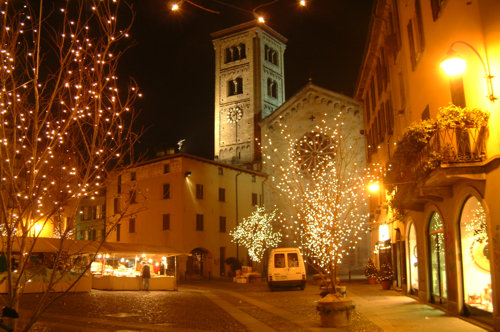|
It is a meaningful example of Lombardic Romanesque architecture and masterpiece of the comacini masters. It rose on the early-christian church of the Saintest Apostles, whose perimeter is marked on the today's floor from black marble bands, and it is dedicated to the patron of the city, fourth bishop of Como.
The building was cathedral of the city until 1013 when this title it was transferred to the church of Santa Maria Maggiore, then demolished in order to make room to the Dome.
The church that we see today was built between 1050 and 1085 by the Benedictines monks and was consecrated by Pope Urbano II in 1095.
The temple, that presents elements of affinity with the cultures beyond the Alps, has endured in the centuries tamperings and various restorations, but the restorations of the past century and those of 1936, have given back to it the original shape.
The church has a severe and unadorned facade, chanted by sturdy pilaster strips that lean on four columns, already belonged to the porch with two floors added between the XII and XIV century and subsequently eliminated. Two bell towers frame the central apse, whose single-lancet windows are adorned by floral, zoomorphic and geometric reliefs.
Remarkable also the Romanesque sculptures that embellish the portal.
Inside, the main nave, covered from flat ceiling, is supported by high columns of tans with cubical capitals; the aisles are divided by columns, some are monolithic, made of granite, except one made of cipolin, and covered by a trussed ceiling. In the pavement it is marked, with black marble bands, the perimeter of the previous church.
The basilica was subject of remarkable works of restoration that discovered a series of frescoes dated to the half of the 1300's. The main ones represent the life of Christ; in the vault, - Christ between Mary and John, Peter and Paul, in the pilaster strips, - the King of the David's lineage, Prophets and Saints.
Under the main altar the mortal remains of the Patron Saint are kept.
|






 The Como-Brunate railroad, that connects the lake with the mountains, was opened in December 1894.
The Como-Brunate railroad, that connects the lake with the mountains, was opened in December 1894. The cathedral is the result of more than four centuries of working; the construction began in 1396 on the anci ...
The cathedral is the result of more than four centuries of working; the construction began in 1396 on the anci ... It is in the center of the city, in the homonymous public square; it comes from the addition of a longitudinal ...
It is in the center of the city, in the homonymous public square; it comes from the addition of a longitudinal ...